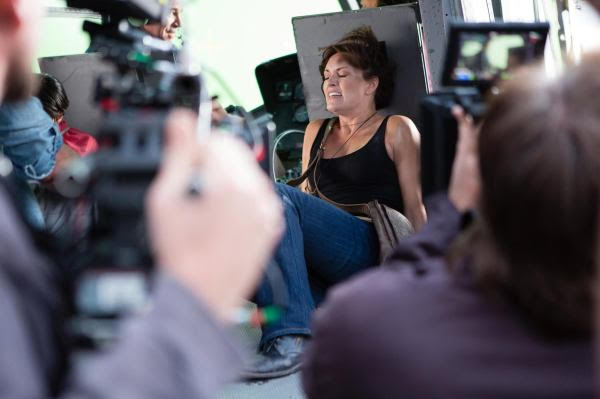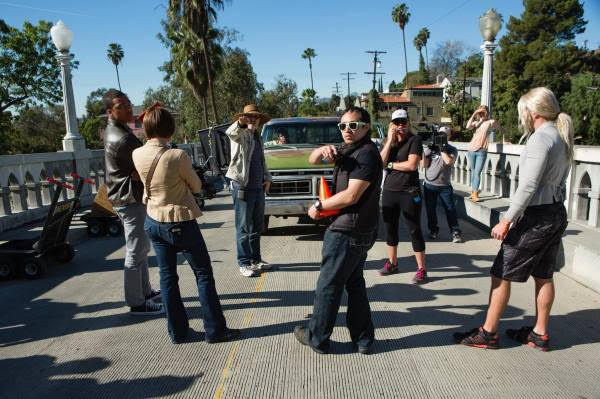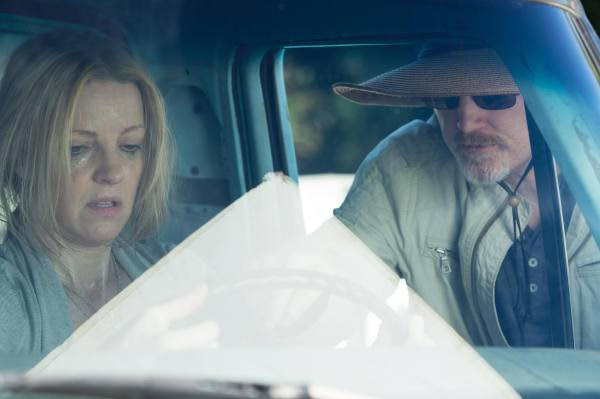Making San Andreas Quake
It’s a big challenge making a film for the Asylum, as their budgets and schedules are incredibly restrictive and small. That includes the time to write. In this case, I had about 4 weeks to write the script (along with a little help from some ghostwriting buddies), which actually overlapped with the prepping of production. (Which sometimes meant you were prepping scenes that weren’t yet approved or in some cases even yet written!) The main intention of the script was to create characters that had a lot of organic, interpersonal conflict, to help propel the story.
With a very limited budget and schedule, you have to very wisely pick your battles, where you’ll spend your resources. Having characters with believable conflicts not only would help ground the story, but would help the budget and schedule. This explains why Molly and Nick find themselves having their arguments in the car over and over again, for better or for worse. Thankfully it was organic to the story, if perhaps lacking cinematically. A worthy compromise because it meant we could spend more time on the action sequences.
There were a couple sequences which I made sure to give as much shooting time to as possible. (And again, we’re talking LITERALLY 10X less time than the big-budget version would enjoy). Those sequences included the carjacking scene (I love the actress Blaire Chandler and felt she could deliver a special performance, and the scene could stand dramatically on its own without VFX or pyrotechnics.) Also, the finale scene where Nick goes flying out the window was the sequence I tried to hardest to protect for shooting time. If you watch it closely, the number of stunts, cuts, and shots is well above what is usually allowed on these budgets, so if there’s any sense of cinematic action and danger, it’s because we sacrificed in other places so that scene could have the time. I owe a big debt of gratitude to my stunt coordinator Kyro Waveborne, who pulled a lot of favors and was always pushing me to do bigger and better, beyond what the budget would allow, all while making safety the absolute priority, another rare thing on budgets and schedules of this size. Kyro always had great ideas on set that were truly dynamic and cinematic but often we simply didn’t have the time, and I know that was frustrating. But I think he still pulled off some amazing feats, whether it be the stunt driving, the stunt falls, or how he trained our actors to do their own stunts when conditions allowed.
Working with the cast was a blast, not a bad apple in the bunch. Jhey Castles and Jason Woods, with whom I worked the most, were up for anything, grateful to be there, and very fun. They never lost their cool, always had a smile and a joke, and that’s a great energy to have around as the crew and I were losing our minds to the stress sometimes. Ben Demaree, our DP, is unflappable and a really gifted artist, and although it took a few days for us to adjust to each others’ rhythms, we got our stride and I knew I could trust him for some beautiful lighting and operation that well exceeded the resources and budget he had to work with. You could set your watch by his lighting time estimates and nine times out of ten you couldn’t believe he threw together what he did in the time allotted. Plus he and Jhey had a fun history together on two other Asylum films (Apocalypse Pompeii and Hansel vs. Gretel), so it was a happy reunion for them.
The movie was limited to 100 visual effects shots, which is pretty restrictive for a disaster movie (as comparison, my last VFX project, MIDNIGHT SUN, was a 4-minute film with 42 VFX shots). I had to be very disciplined about this. In prep, I drew up spreadsheets accounting for every VFX shot, based on my storyboards and diagrams, and I had to stick to it religiously. Joe Lawson and his VFX team at The Asylum had a very, very full pipeline with a number of films being worked on ahead and after mine, none-the-least being SHARKNADO 3. So it meant going over the limit would not be tolerated, as well as the fact that they would only have little more than 3 weeks to complete the shots for the entire movie. Joe Lawson, the VFX supervisor, is wonderfully fun and really cares, so in addition to being a fantastic and generous guide, he delivered the very best that the time and budget allowed, and sometimes, miraculously, beyond those limits. But, there is only so much time, and some shots are what they are and that’s perhaps the charm of an Asylum movie. But some of the shots, the ones we earmarked as important from the beginning, got the loving they deserved, and hold up exceptionally well, I feel.
I think when all is said and done, you do the best you can with what you’re given. On these films the resources are maddeningly limited, so for me, it became an exercise in letting go. I’m usually very anal and fastidious about my work, but a picture like this just doesn’t allow for it. And that’s a spiritual journey – letting go, seeing what good can come out of the chaos if you put your best foot (and prep) forward. That the movie is watchable and fun, I hope, is a testament to that. As hard as it was, I’m certainly grateful to the Asylum that I had the experience.



